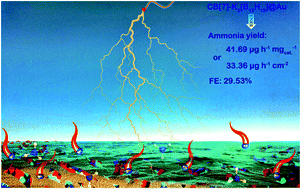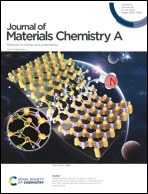Potassium ions promote electrochemical nitrogen reduction on nano-Au catalysts triggered by bifunctional boron supramolecular assembly†
Abstract
The electrochemical way of reducing nitrogen to ammonia presents green and economic advantages to dial down irreversible damage caused by the energy-intensive Haber–Bosch process. Here, we introduce an advanced catalyst CB[7]–K2[B12H12]@Au with highly dispersed and ultrafine nano-gold. The CB[7]–K2[B12H12]@Au electrochemically driven ammonia yield and Faraday efficiency is as high as 41.69 μg h−1 mgcat.−1 and 29.53% (at −0.4 V vs. RHE), respectively, reaching the US Department of Energy (DOE) utility index of ambient ammonia production along with excellent cycle stability and tolerance that indicates a high potential of industrial practical value. Experimental results and theoretical calculations show that the key to an excellent electrochemical nitrogen reduction performance lies in the smart design of the CB[7]–K2[B12H12]@Au catalyst combining the stable substrate anchored Au nanoparticles and K+ ions that effectively prevent the hydrogen evolution reaction and polarize *N2 leading to lowering of the rate determining step. This research will promote the further development of electrochemical ammonia production with low environmental impact.



 Please wait while we load your content...
Please wait while we load your content...